After the long winter months of grayling fly fishing, March heralds the beginning of the brown trout fishing season on the Welsh Dee (3rd of March). So, to help you get off to a good start, this post goes through my…
Top Trout Flies for March.
March heralds the start of spring in the calendar, but it can still be wintery weather at times on the Welsh Dee. Therefore, March is a month of transition from a wintery start to a spring-like end.
Occasionally, however…
Winter can return at the end of March...
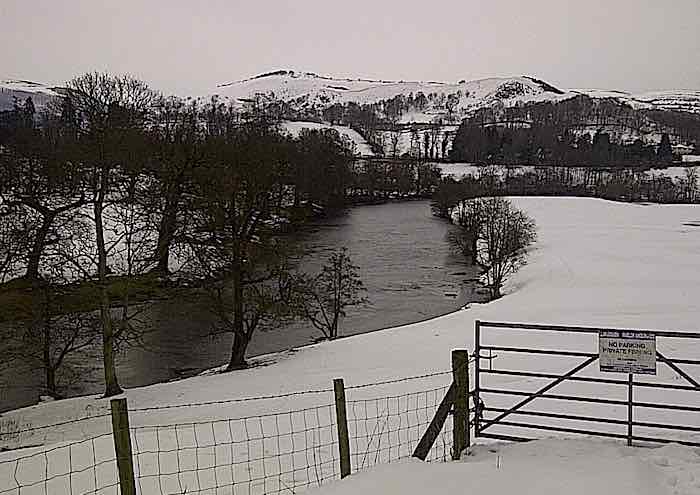
This guide was produced using my fishing log, which contains information on the river and weather conditions, fly fishing methods, flies, and catch returns for each fishing trip.
Trout flies for March – key selection variables:
a) Weather conditions:
Fortunately, the general transition from winter to spring results in weather warming up during March.
The historical average temperature for Llangollen at the start of March is a daytime high of 8oC and a night-time low of 3oC. However, this rises to a high of 10oC and a low of 4oC by the end of March.
As the temperature warms, fly hatches become more prevalent in March. For example, the flies hatching on the Welsh Dee include…
- Large Dark Olives
- March Browns
- Large Brook Dun
- Stone Flies
- Grannom (at the end of March, if the temperature has been above average)

b) River conditions:
After reviewing the data in my fly fishing log, the two river conditions with the largest effect on fly selection for March were…
River Level & Water clarity
Further data analysis revealed that water clarity was more important than the river level. Thus, I used water clarity for the second fly selection variable.
At high river levels, water clarity influenced fly selection more than river height because, in coloured water, Euro / Czech nymphing was the best method.
Consequently, I’ve used air temperature and water clarity to define four subgroup conditions for March fly selection. For each subgroup, I share flies and fishing approaches that catch trout.
River height has a minor influence on fly selection and is covered where relevant.
So, let’s look at how all of the above effects…
My Go-To trout flies for March?
a) Clear-water trout flies for March on cold days
Often, on cold (< 6oC) days, surface fly life is absent at the start of the day. Therefore, I will start by fishing a team of nymphs close to the riverbed because this is where the trout will be feeding.
If the temperature warms during the day, watch out for any hatching flies (midges or large dark olives) or rising fish. When this happens, I usually find it best to switch to fishing a team of spiders or wet flies and occasionally a dry fly.
Below are two wet flies and a nymph that continue to work well for me:

TB Black Pennell
- Kamasan KB175 (#12)
- 3 mm tungsten bead
- Black UNI-thread 8/0
- Tail – Golden Pheasant tippet
- Rib – fine silver wire
- Body – black Uni-floss
- Hackle – black hen
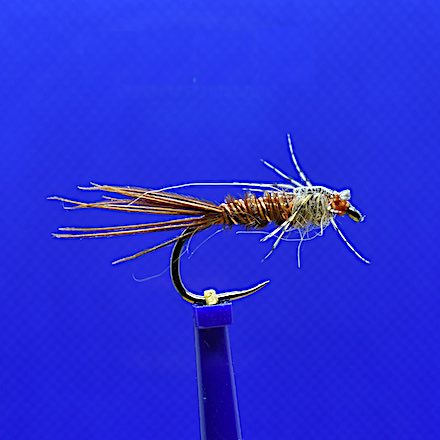
Pheasant Tail nymph
- Kamasan B175 (#12 & #14)
- Rusty orange UNI-thread 8/0
- Tail – pheasant tail fibre tips
- Body – 3 pheasant tail fibres
- Rib – fine copper wire
- Thorax – Hare’s Ear dubbing
- Legs – brown partridge neck feather tip (optional)
- Wing case – natural nymph skin
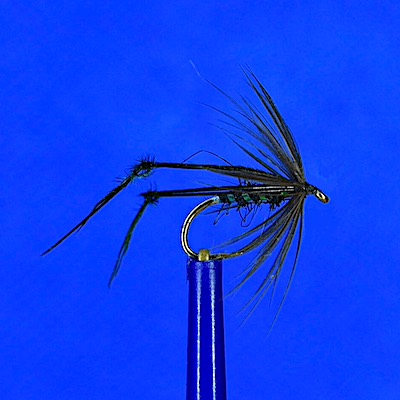
Black Hopper
- Kamasan B170 (#14)
- Black UNI-thread 8/0
- Body – black seal fur substitute
- Rib – Uni Pearl Mylar #14 (1/32)
- Legs – Knotted black pheasant tail fibres
- Black hen hackle
b) Clear-water trout flies for March on mild days
Towards the end of March, the temperature can rise above average (i.e. into the low teens). Under mild conditions (> 8oC), fly hatches often start mid-morning and extend into late afternoon. During these conditions some excellent sport fishing a dry fly is possible.
Dry flies for March
The Large Dark Olive is the most common fly seen hatching on UK rivers during March. I usually tie on the Jingler fly to imitate these large olives.
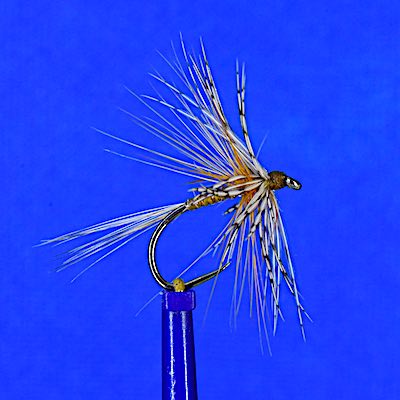
Jingler dry fly
- Hook: Kamasan B170 #14 & 12
- Thread: brown 8/0 Uni-Thread
- Tail: Badger cock fibres
- Body: Hends body quill BQ-32
- Rear hackle: Ginger cock
- Front hackle: Grey partridge
The Elk Hair Caddis is the other dry fly I have found indispensable for March because it is an excellent general imitation for olives and March Browns.
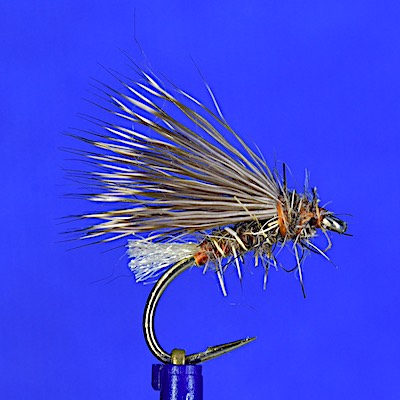
Elk Hair Caddis
- Hook: Kamansan B170 (#14 & 12)
- Thread: 8/0 Burnt orange
- Tag: Cream Antron Yarn
- Body: WASPI Fox Squirrel dubbing
- Rib: Gold wire
- Wing: Natural elk hair
If trout refuse the caddis then try the Fox Squirrel Klinkhammer emerger pattern:
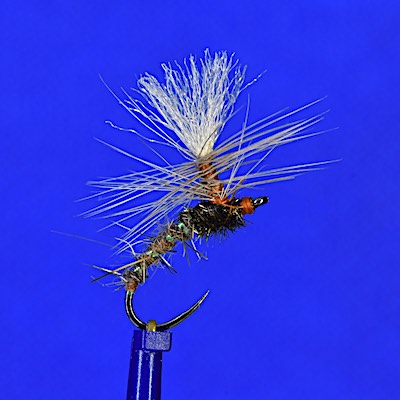
Fox Squirrel Klinkhammer
- Hook: HENDS BL550 size 14
- Thread: Burnt orange Uni-Thread 8/0
- Wing: Crea, Poly Yarn
- Hackle: Medium Dun Metz cock saddle
- Body: WASPI fox squirrel dubbing
- Rib: Pearl Mylar tinsel
- Thorax: Peacock herl
Wet flies for March
On mild days in March, I have found that wet fly fishing is often the most reliable fishing method, even when flies are fluttering off the river. However, that should not stop you from enjoying some early-season dry fly fishing.
In addition to the wet flies covered in section (a), the March Brown spider and pearly-butt waterhen Bloa are great options for early-season brown trout.
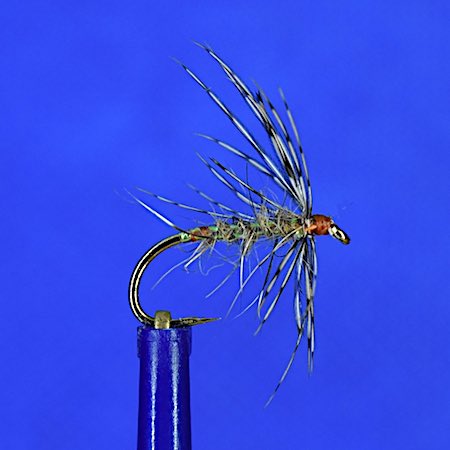
PR March Brown Spider
- Kamasan B170 (#14)
- Thread – brown UNI-thread 8/0
- Body – Hare’s Ear dubbing
- Rib – Uni Pearl Mylar #14 (1/32)
- Hackle – Brown partridge neck feather
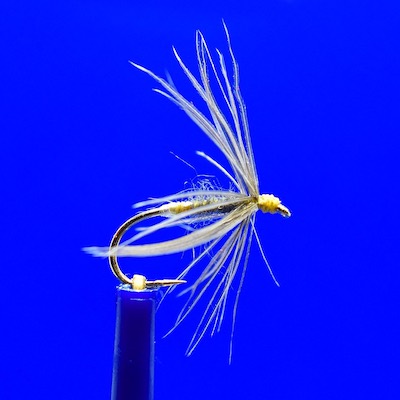
Pearly-butt Waterhen Bloa
- Hook – Kamasan B170 (#14)
- Thread – brown UNI-thread 8/0
- Body – Hare’s Ear dubbing
- Rib – Uni Pearl Mylar #14 (1/32)
- Hackle – Brown partridge neck feather
c) Coloured-water trout flies for March on cold days
When faced with a coloured river running off after a spate, I will always start fishing with a team of nymphs close to the riverbed using my Vision Nymphmaniac fly rod.
The fishing is usually hard work on cold days, and often I have to resort to using heavy nymphs and the squirmy wormy to avoid a blank.
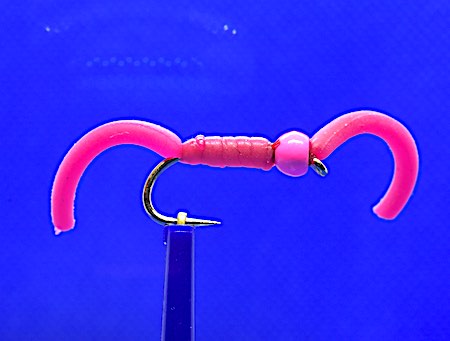
Pink Squirmy Worm
- #14 barbless hook
- 3.5mm pink tungsten bead
- Pink UNI-thread 6/0
- Body/tail – Veniard Pink worm body
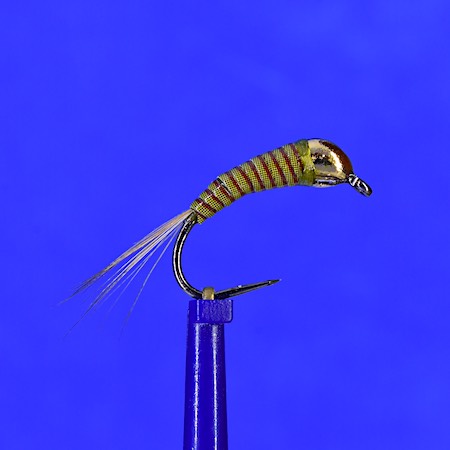
TB Olive Jig-back
- Partridge Grub & Buzzer (#14 & #12)
- Large gold tungsten jig-back
- Thread: 8/0 Olive thread
- Body: Olive synthetic quill
- Tail: grizzle cock fibres
d) Coloured-water trout flies for March on mild days
When the river is coloured, I prefer to fish a team of nymphs close to the riverbed. However, on mild days trout can be feeding higher in the water column on hatching flies.
If that happens, I’ve had good results with both of the following nymphs fished on the middle and top droppers.
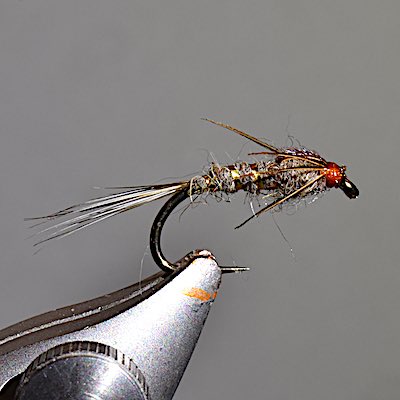
GR Hare’s Ear
- Hook: #16 to 12 Kamasan
- Weight: up to 6 turns of lead wire
- Thread: Rusty brown 8/0 Uni-Thread
- Tail: Ginger cock fibres
- Body & Thorax: Light Hares Mask – WAPSI
- Rib: Gold tinsel
- Thorax cover: 6 pheasant tail fibres
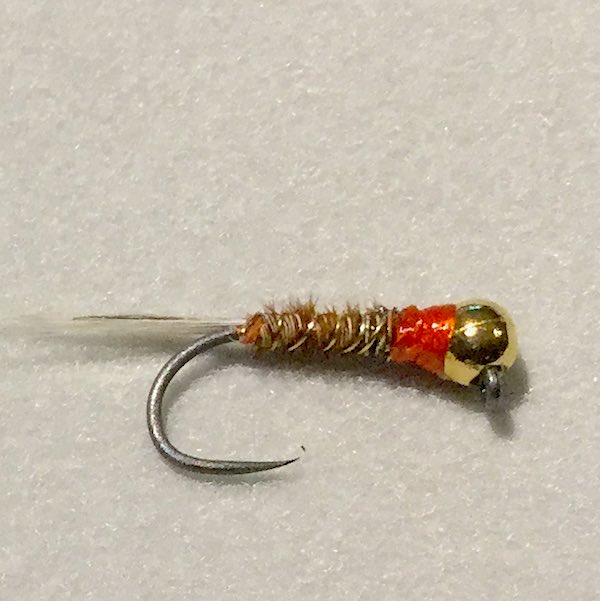
TB Pheasant Tail Nymph
- HENDS BL154 (#14)
- 2.5mm gold tungsten bead
- Orange UNI-thread 8/0
- Tail – 3 pheasant tail fibres
- Body – 3 pheasant tail fibres
- Rib – fine copper wire
- Collar – orange Uni-thread 8/0
If all the above methods have failed, fishing streamer patterns on a DI5 sinking line close to the bottom of deep pools can avoid a blank.
A grey Woolly Bugger pattern is an ideal bait-fish streamer pattern and has been a saviour in March on tough days.
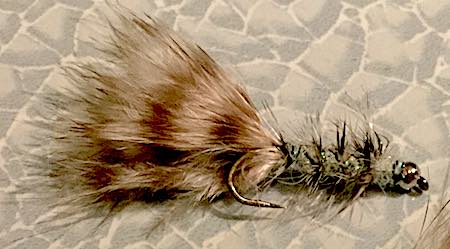
TB Grey Woolly Bugger
- Kamasan B800 (#10) – debarbed
- 3mm silvered tungsten bead
- Grey UNI-thread 6/0
- Tail – Grey/brown barred Marabou
- Body – Pearl Glister dubbing
- Hackle – palmered badger cock
- Rib – fine silver wire
Takes are often savage, so hold your rod up at a 30-degree angle to absorb shock and avoid snapping the leader.
Summary of my trout flies for March:
I produced the following infographic to summarise when to fish my trout flies for March under different river conditions.
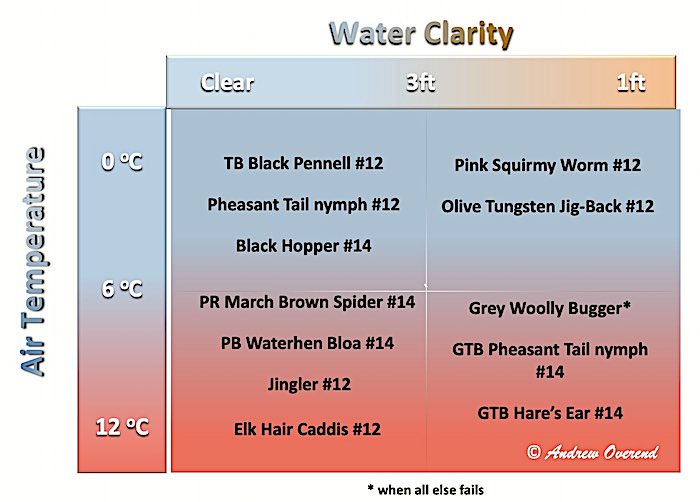
Finally, if I had to simplify trout fly selection for March further, say for newcomers to the Welsh Dee. Then…
my top 3 trout flies for March would be…
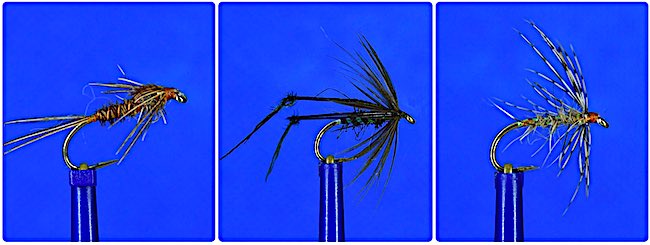
L to R – point: Pheasant Tail Nymph: middle dropper: Black Hopper; top dropper: PR March Brown Spider
My reason is that they consistently catch Welsh Dee trout and have accounted for more than half of the fish I caught during March.

For more on fishing during March, I’ve added links to interesting posts.
If you are interested in fishing on the Welsh Dee there is some excellent Day Ticket water at Llangollen.
I hope you enjoyed this article, and it would be great to hear about your favourite trout flies for March in the comment section below.

Extremely detailed, thank you, I’m printing this info now!….
Where do you suggest I buy my flies from Andrew, it needs to be on line now, but I’m desperate to stock up on your suggestions?
Hi Richard,
Great to hear you enjoyed the article and thanks for the feedback.
I tie all my own flies and rarely buy any. I have come across a couple of people who have some good looking flies and maybe they cover what you are likely to need. https://www.yorkshire-dales-flyfishing.com/ and https://shop.garethlewisflyfishing.com/
I hope this helps, Andrew
Thanks Andrew I will have to start tying some nymphs and
Great to hear.
HI Andrew
another brilliant piece well done
Thanks
Very informative as all your fishing articles are . Not long before I put them into practise
Hi Tim,
Glad you enjoyed the article. Hopefully, there will be no more setbacks and we can all get out fishing on the river.
Cheers, Andrew
Another excellent piece, inspiring for the new season, many thanks.
Cheers
Great article,as always.very informative and inspirational.
Cheers
Hi Andrew, I enjoy all your posts, whatever species you are targeting. Keep up the great work, it’s much appreciated.
Hi Richard,
Thanks for the feedback and its great to hear you are enjoying my post.
Andrew
Great article Andrew, clear and precise without all the “fuss” of others! Can you recommend a fly tying starter kit , there as soo many ion the market that I have just become bewildered .
cheers
Glynn
Hi Glynn,
If you let me know what type of flies you are planning to start tying I will recommend something.
Regards, Andrew
Hello,Andrew. I am writing from Spain. I got interested in fishing north spiders a couple of months before the starting of the trout season (last Sunday,actually) I was looking for some info on the web and I run into your wonderful blog. I have a couple of questions. I’ve seen some vids of upstream fishing with the NS and I wonder how do you make the flies sink using a floating line. Or, given the sparse dressing do they sink all right? Also,I asume you can fish the downstream too. Do you in that case fish them like any other wet,ie. 45° and arc drifting or just a dead drift with slack line ?
Sorry,I think I have gone a bit too far with my questions. In any case, congrats for your blog and thanks.
Xaquín López
Hi Xaquin,
Great to hear you found my blog and enjoyed the article. When fishing upstream if you degrease the leader the flies will sink slightly as they drift downriver. If you want them to sink further add a weighted spider on the point and it will pull the other down. When fishing downstream I usually fish them like traditional wet flies.
I hope this helps, Andrew
This has been my constant go to site for ages. The fly dressings and fishing information from Andrew is spot on.
Hi Keith,
Great to know you are finding the website useful.
Thanks for the feedback. Cheers, Andrew
Thanks Andrew for a great post as usual, just tying some of your suggested patterns today and will give the go on the Ribble soon. Cheers again
Hi Ray,
I hope they work well on the Ribble. Also would be good to know how you get on.
Tight lines, Andrew
Hi Andrew
Used this information recently to fish the River Dee at Shocklach, Warrington Anglers stretch, and caught 7 grayling, 5 on a beige klinkhammer and one each on the elk hair caddis and jingler. The weather was cold, 5 degrees, but the fish were rising to these flies nothing on the wet flies. Thanks for the advice. Tim Gee.
Hi Tim,
Great to hear my fly recommendations for March are bringing you some success.
Thanks for sharing, Andrew
Hello Andrew, I’m a CADAC member and fish the Dee and still water with a 9ft rod, is there any advantage of a longer rod whilst fishing the Dee ?
Hi Denzil,
For dry fly fishing and wet fly fishing a 9ft rod is OK for the Welsh Dee. For tight line nymphing techniques (Euro / Czech nymphing) a longer rod 10 to 11ft (3 or 2#) is a better choice for the Welsh Dee.
I hope this helps, Andrew
Excellent thanks
Cheers